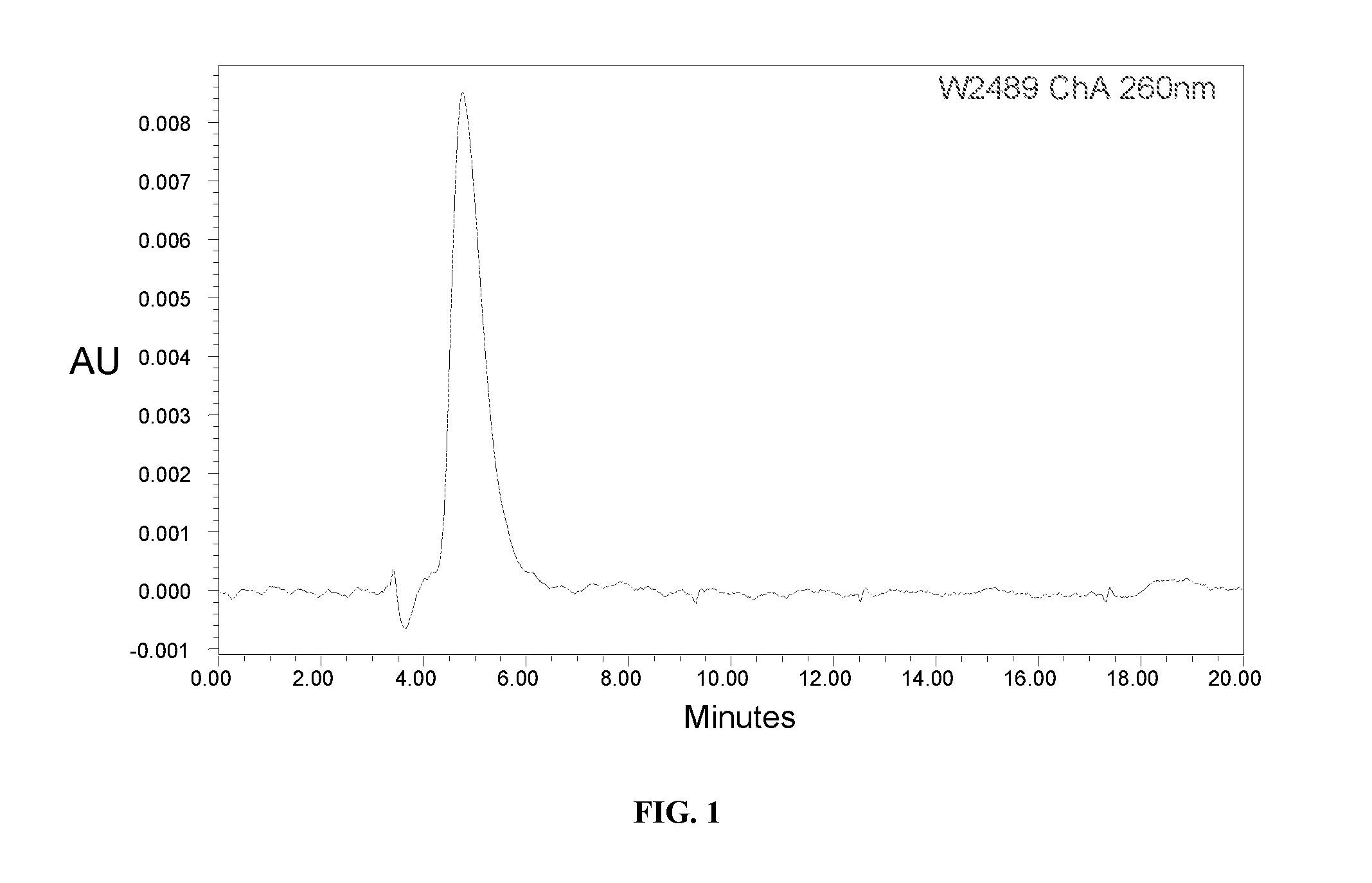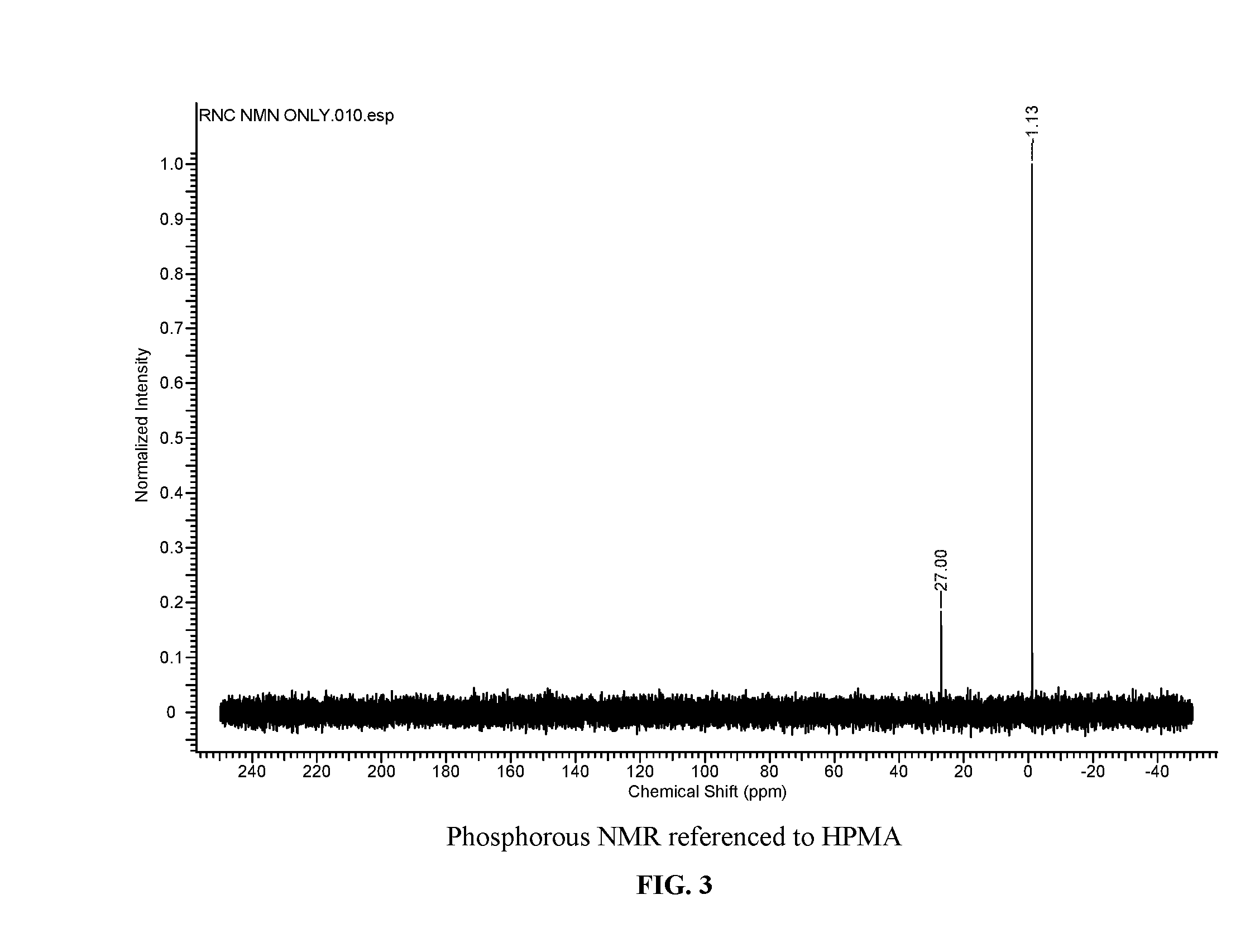Selective solvent free phosphorylation
a solvent-free, selective technology, applied in the direction of group 5/15 element organic compounds, anti-inflammatory agents, drug compositions, etc., can solve the problems of affecting the synthesis efficiency of active hydroxyl groups, and reducing the nicotinate/nicotinamide riboside
- Summary
- Abstract
- Description
- Claims
- Application Information
AI Technical Summary
Benefits of technology
Problems solved by technology
Method used
Image
Examples
example 1
Synthetic preparation of Nicotinamide mononucleotide (NMN): Compound of Formula (I): R1=hydrogen, n=0, Z2=NH, R2-R5=hydrogen, Y1=sodium, Y2=internal salt with pyridinium
[0231]
Nicotinamide Mononucleotide (NMN)
[0232]To a dry 35 mL PTFE milling vessel containing one PTFE ball (0.8 cm diameter) was added nicotinamide riboside chloride (2000 mg, 6.88 mmol, 1.0 eq) and POCl3 (2.57 mL, 27.52 mmol, 4.0 eq). The reaction was then milled at 30 Hz for 60 minutes or until the reaction had reached ˜95% conversion via c-18 HPLC analysis. The gum-like, gum-coated ball was removed and placed into a wide-necked flask, and the residue was solubilized in a minimal volume of distilled water over ice. The solution was adjusted to pH 6.0 by the drop-wise addition of a 2M NaOH solution. The aqueous solution was then reduced to a small volume under high vacuum and the pH was then adjusted to pH 3.0 using dilute nitric acid. To the aqueous solution was then added acetone (ca. 300 mL) and the precipitated wh...
example 2
Synthetic Preparation of Thiaminyl Monophosphate.
[0243]
Thiaminyl Monophosphate
[0244]To a dry 35 mL PTFE milling vessel containing one PTFE ball (0.8 cm diameter) was added thiamine HCl (2000 mg, 6.63 mmol, 1.0 eq) and POCl3 (2.43 mL, 26.51 mmol, 4.0 eq). The reaction was then milled at 30 Hz for 60 minutes, or until the reaction had reached near completion by 1H-NMR analysis. The white, paste-like residue was then solubilized in a minimal volume of distilled water over an ice bath and then concentrated, to give a fluffy white powder (92% conversion).
[0245]1H NMR (400 MHz, D2O) δ ppm 9.51 (s, 1H, Ar), 7.79 (s, 1H, Ar), 5.38 (s, 2H), 4.46 (q, J=5.4 Hz, 2H), 3.15 (t, J=4.9 Hz, 2H), 2.43 (s, 3H), 2.36 (s, 3H). 13C NMR (125 MHz, D2O) δ ppm 163.2, 163.0, 155.0, 154.9, 144.3, 143.3, 135.5, 106.2, 64.8, 49.9, 27.5 (d, J=10.3 Hz), 20.9, 11.1. 31P NMR (162 MHz, D2O) δ ppm −0.62.
[0246]The chlorination product is identified by chemical shifts observed at 2.99, 3.69, 7.83, and 9.47 ppm on the 1H...
example 3
[0247]Synthetic Preparation of Pyridoxyl Monophosphate
Pyridoxyl Monophosphate
[0248]Pyridoxine (500 mg, 2.99 mmol, 1.0 eq) and POCl3 (1.12 ml, 11.96 mmol, 4.0 eq) were added to a 50 mL ceramic mortar, and the mixture was then hand-grinded for 30 min total, using a ceramic pestle. 1H NMR analysis showed 20% conversion to the desired product. 1H NMR (400 MHz, D2O) δ ppm 8.01 (1H, s, Aldehyde), 6.84 (1H, s, Ar), 5.24 (1H, m, CH2O), 5.10 (1H, m, CH2O), 2.49 (3H, s, CH3). 31P NMR (162 MHz, D2O) δ ppm −1.03.
PUM
| Property | Measurement | Unit |
|---|---|---|
| particle size | aaaaa | aaaaa |
| diameter | aaaaa | aaaaa |
| pH | aaaaa | aaaaa |
Abstract
Description
Claims
Application Information
 Login to View More
Login to View More - R&D
- Intellectual Property
- Life Sciences
- Materials
- Tech Scout
- Unparalleled Data Quality
- Higher Quality Content
- 60% Fewer Hallucinations
Browse by: Latest US Patents, China's latest patents, Technical Efficacy Thesaurus, Application Domain, Technology Topic, Popular Technical Reports.
© 2025 PatSnap. All rights reserved.Legal|Privacy policy|Modern Slavery Act Transparency Statement|Sitemap|About US| Contact US: help@patsnap.com



